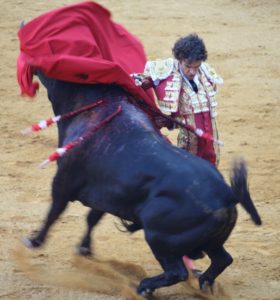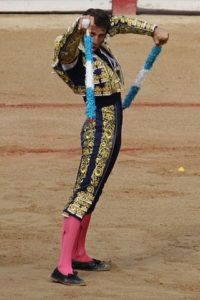For all the controversy, this running of the bulls won’t be Pamplona’s last
BY ALEXANDER FISKE-HARRISON ON 7/4/14
The most dangerous party on Earth begins each year at midday on July 6th and keeps going without pause until midnight on the 14th
At 8am each morning, a herd of six Spanish fighting bulls will stampede through half a mile of streets from the edge of Pamplona to the corrals of the city’s bullring. The herd will then spend the day recovering until the bullfighting begins in the evening, as has happened every year since 1591.
Also running in those streets will be between one and three thousand people, in various states of drunkenness, sleeplessness and sheer terror.
Since records began in 1923 – which happens to be the year Ernest Hemingway first attended this ‘fiesta’ – 15 people have died running with the bulls, and every year there are dozens of serious injuries at what officially is called the Feria [Fair] of San Fermin, patron saint of Navarre in Northern Spain.
This year there will be added tension following the news that during the other great feria of the Spanish bullfighting season, San Isidro in Madrid, a bullfight last month was cancelled for the first time in 35 years after all three matadors sustained serious injuries.
If hardened professionals, who have faced over a thousand bulls between them, end up in intensive care, how are the thousands of first timers and tourists in the streets of Pamplona supposed to survive?
What’s more, the bulls in Pamplona will come from the famous Jandilla ranch belonging to Juan Pedro Domecq – for only the second time since one of Domecq’s bulls killed the young Spanish runner, Daniel Jimeno Romero, in 2009.

Ancient bloodlines and fresh blood are what bullfighting is all about. Aficionados are quick to point out that it is not called the bullfight in Spanish, but the corrida de toros, meaning ‘course’ or ‘race’. It is not viewed as a fight at all, and is written about in the cultural, rather than the sporting sections of the newspapers. As Hemingway headlined his first article on the subject after that Pamplona visit for the Toronto Star: ‘Bullfighting is not a sport – it is a tragedy.’
Spanish bullfighting came from the knightly jousting of bulls, which ended with a servant finishing the animal off, hence his title, matador, meaning ‘killer’. When the French Bourbons took the Spanish throne in 1700, they frowned on their nobility indulging in what they saw as a barbaric pastime, but the public appeal for the spectacle continued. As a result, the professional matador came into existence, beginning with Francisco Romero, born in Ronda in 1700, who hired lance-wielding horsemen called picadors to fulfil the knight’s role – and this remains to this day the first act of the bullfight.
Romero also hired assistant bullfighters called banderilleros, to place the banderillas – barb-pointed multi-coloured sticks – before the final act, el tercio de la muerte (‘the third of death’, which involves the matador facing the now much diminished bull with a sword in one hand and a red cape known as the muleta in the other.
It is this final encounter between the lone torero and the toro which stirs the crowd: a combination of statuesque elegance in the face of the charging animal and suavity of movement.
Because its purpose is not ‘winning’ – even if the bull were to kill the matador, another matador would kill it – bullfighting is seen as an artform. The matador’s role is to to effect ‘emotional movement’ and for this reason they are ranked and paid as much as they are. The greatest matador of the current era, José Tomás, has been paid as much as a million Euros for a single afternoon’s work.
However, it is also, in Hemingway’s words, “the only art in which the artist is in danger of death” and 533 professional bullfighters have been killed since 1700. José Tomás has suffered 15 serious gorings, including one in 2010 where he lost twice the blood content of his body: the doctors poured it in and it poured out through the wound. Just last week he was awarded an ear of a bull he faced – a trophy awarded by the crowd for excellence – despite having a broken rib from a bullfight in Granada the week before.
Today, the fight to keep bullfighting or outlaw it has intensified. Currently, it is practised in Spain, France, Mexico, Colombia, Ecuador, Venezuela and Peru. The animal rights lobby group PETA – People for the Ethical Treatment of Animals – calls it “an atrocity, not a sport” based on “an unfair fight”.
Devotees, such as Dr Gabriel Avalos, a Madrid-born teacher of philosophy and lifelong aficionado of the bulls, dismisses such criticism out of hand.
“Where is the fairplay for the 3 million cattle that are killed in the UK, of the 30 million killed in the US, 78% of which are factory farmed, the average age of which at the time of death is 18 months?,” he says.
“The fighting bull lives wild in the forests to build muscle, foraging and fighting his brothers for dominance so he can perform in the corrida and he does this for five years, and dies adrenalized and fighting in 20 minutes in the ring. For him, it is a combat, yes, and he does not know he can never win. How long do his meat cow cousins stand queuing, smelling the stench of death in front of them? The doctors now tell us we don’t need to eat meat, so why do those animals die? For our entertainment, as does the fighting bull, but before he enters food chain, he lives like a king, and dies, venerated like a god.”

It is not just the welfare of the animals which is questioned, though, but also its affect on people. In 2006, the then socialist government of José Luis Zapatero banned live transmissions of bullfights on Spain’s public broadcaster TVE. That same year, a Gallup poll showed that 72% of Spaniard’s had “no interest” in bullfighting, and this decline seemed to reach a high point in 2010, when the regional parliament of Barcelona voted to ban corridas throughout Catalonia.
However, the overall picture is more complex. In 2007, at the height of Spain’s financial boom, there were 2,644 major bullfights in Spain – more than ever before in Spanish history – and 5,000 minor ones, making the activity a €2 billion a year industry employing 250,000 people.
The numbers have declined to almost a third since then, although whether this is from a fall in popularity or the absence of expendable wealth on entertainment during a historically bad economic crisis is unclear. PETA cites the 2006 Gallup poll but not the Gallup poll from two years later in 2008, when that figure was back down to 68%, the same figure Gallup found in 2002.
Crucially, many Spaniards saw the Barcelona ban as driven by separatist politics rather a concern for animal welfare, not least because Catalan nationalist parties argued the bullfight had been forced on them as a culturally unifying influence under the dictatorship of General Franco. When the left-wing newspaper El Pais commissioned a poll on the subject following the ban, it found that although 60% of Spaniards didn’t like bullfighting, 57% were against banning it.
It was in part because of this that the conservative government of Mariano Rajoy has not only returned bullfights to Spanish television as of 2012, but last year classed it as a “protected cultural patrimony”, federally precluding any further regional bans.
We have been here before. In 1771, the Bourbon King, Carlos III, banned it outright, although his successor repealed the prohibition in 1805. The last Bourbon – or rather Borbón – King, Juan Carlos I was a devoted aficionado who had even faced small bulls in the ring himself as a young man. Whereas his son, the recently crowned King Felipe IV has made no public statements on the subject, and has not been seen at a corrida since 2009 when he took his father’s place in the Royal box in Madrid.
King Felipe is wise to remain silent. There are plenty of others voices, on both sides of the argument, who will want to be heard.

